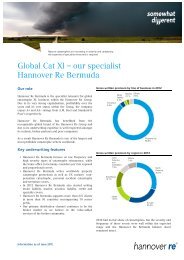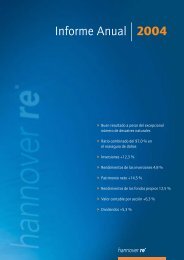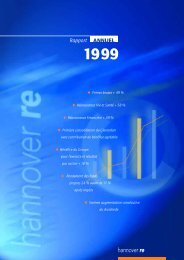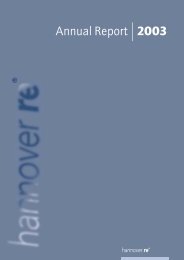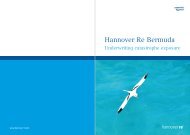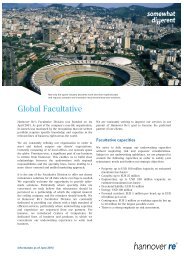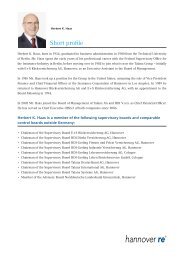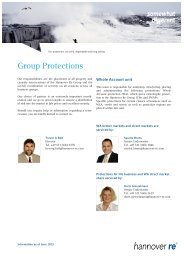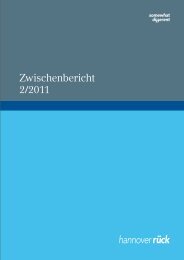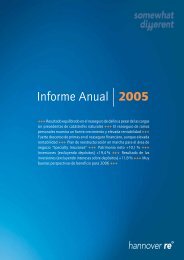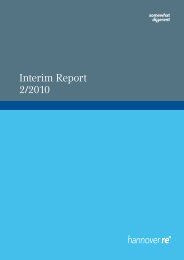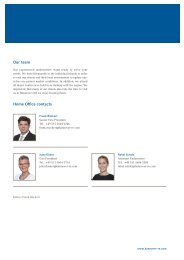Annual Report 2010 - Hannover Re
Annual Report 2010 - Hannover Re
Annual Report 2010 - Hannover Re
You also want an ePaper? Increase the reach of your titles
YUMPU automatically turns print PDFs into web optimized ePapers that Google loves.
of the fair value less historical cost and less prior value adjustments,<br />
meaning that depreciation is taken on the fair value as<br />
at the closing date – if available, on the publicly quoted stock<br />
exchange price.<br />
Netting of financial instruments: financial assets and liabilities<br />
are only netted and recognised in the appropriate net<br />
amount if a corresponding legal claim exists or is expressly<br />
agreed by contract (reciprocity; similarity and maturity), in<br />
other words if the intention exists to offset such items on a net<br />
basis or to effect this offsetting simultaneously.<br />
Other invested assets are for the most part recognised at<br />
nominal value. Insofar as such financial assets are not listed<br />
on public markets (e.g. participating interests in private equity<br />
firms), they are carried at the latest available “net asset value”<br />
as an approximation of the fair value. Loans included in this<br />
item are recognised at amortised cost.<br />
Investments in associated companies are valued at equity on<br />
the basis of the proportionate shareholders‘ equity attributable<br />
to the Group. Under IAS 28 “Investments in Associates”,<br />
which requires the application of the equity method based on<br />
the investor‘s share of the results of operations of the investee,<br />
the goodwill apportionable to the associated companies must<br />
be recognised together with the investments in associated<br />
companies. The year-end result of an associated company relating<br />
to the Group‘s share is included in the net investment<br />
income and shown separately. The shareholders‘ equity and<br />
net income are taken from the associated company‘s latest<br />
available financial statement.<br />
Contract deposits: under this item we report contract deposits<br />
under insurance contracts that satisfy the test of a significant<br />
risk transfer to the reinsurer as required by IFRS 4<br />
“Insurance Contracts” but fail to meet the risk transfer required<br />
by US GAAP. IFRS 4 in conjunction with FASB ASC<br />
944-20-15 requires insurance contracts that transfer a significant<br />
insurance risk from the ceding company to the reinsurer<br />
to be differentiated from those under which the risk transfer<br />
is of merely subordinate importance. Since the risk transfer<br />
under the affected transactions is of subordinate importance,<br />
these contracts are recognised using the “deposit accounting”<br />
method and hence eliminated from the technical account. The<br />
compensation for risk assumption booked to income under<br />
these contracts is netted under other income/expenses. The<br />
payment flows resulting from these contracts are shown in the<br />
cash flow statement under operating activities.<br />
Accounts receivable: the accounts receivable under reinsurance<br />
business and the other receivables are carried at nominal<br />
value; value adjustments are made where necessary on the<br />
basis of a case-by-case analysis. We use adjustment accounts<br />
for value adjustments taken on reinsurance accounts receivable,<br />
while all other write-downs are booked directly against<br />
the underlying position.<br />
Deferred acquisition costs principally consist of commissions<br />
and other variable costs directly connected with the acquisition<br />
or renewal of existing reinsurance contracts. These acquisition<br />
costs are capitalised and amortised over the expected<br />
period of the underlying reinsurance contracts. Deferred acquisition<br />
costs are regularly tested for impairment.<br />
<strong>Re</strong>al estate used by third parties (investment property) is<br />
valued at cost less scheduled depreciation and impairment.<br />
Straight-line depreciation is taken over the expected useful<br />
life – at most 50 years. Under the impairment test the market<br />
value of real estate for third-party use (recoverable amount)<br />
is determined using acknowledged valuation methods and<br />
compared with the carrying value; arising impairments are<br />
recognised. Maintenance costs and repairs are expensed.<br />
Value-enhancing expenditures are capitalised if they extend<br />
the useful life.<br />
Cash is carried at face value.<br />
Funds withheld are receivables due to reinsurers from their<br />
clients in the amount of the cash deposits contractually withheld<br />
by such clients; they are recognised at acquisition cost<br />
(nominal amount). Appropriate allowance is made for credit<br />
risks.<br />
<strong>Re</strong>insurance recoverables on technical reserves: shares of our<br />
retrocessionaires in the technical reserves are calculated according<br />
to the contractual conditions on the basis of the gross<br />
technical reserves. Appropriate allowance is made for credit<br />
risks.<br />
Intangible assets: in accordance with IFRS 3 “Business Combinations”<br />
scheduled depreciation is not taken on goodwill;<br />
instead, impairment is taken where necessary after an annual<br />
impairment test. For the purposes of the impairment test,<br />
goodwill is to be allocated pursuant to IAS 36 “Impairment<br />
of Assets” to so-called “cash generating units” (CGUs). Each<br />
CGU to which goodwill is allocated should represent the lowest<br />
level on which goodwill is monitored for internal management<br />
purposes and may not be larger than a segment. Following<br />
allocation of the goodwill it is necessary to determine for<br />
each CGU the recoverable amount, defined as the higher of<br />
the value in use and the fair value less costs to sell. The fair<br />
value is calculated using a discounted cash flow method on the<br />
118 NOTES 3.2 Summary of major accounting policies<br />
<strong>Hannover</strong> <strong>Re</strong> Group annual report <strong>2010</strong>



